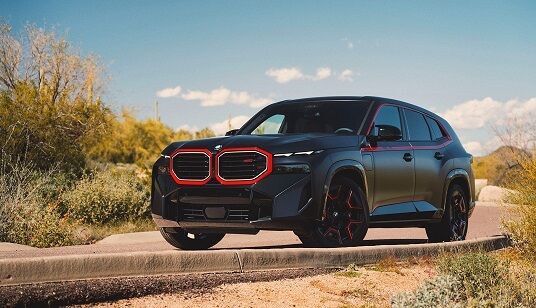


SUV, 5 Doors, 5 Seats
585 Hp @ 5600 rpm.
133.1 Hp/l
250 km/h, Electronically limited 155.34 mph
4395 cm3
268.2 cu. in.
8, V-engine
All wheel drive (4x4),
#N/D
#N/D
#N/D
| Brand | BMW |
|---|---|
| Model | XM (SUV) |
| Version | XM (G09) |
| Engine version | Label Red 4.4 V8 (748 Hp) PHEV xDrive Steptronic |
| Year production start | 2023 |
| Vehicle type | SUV |
| Horsepower RPM | 585 Hp @ 5600 rpm. |
| Acceleration 0 - 100 kmh sec | 3.8 sec |
| Doors | 5 |
| Top Speed | 250 km/h, Electronically limited 155.34 mph |
| Cam configuration | VALVETRONIC, Double-VANOS |
|---|---|
| Engine position and orientation | Front, Longitudinal |
| Cylinders | 8 |
| Position of cylinders | V-engine |
| Displacement (liters) |
4395 cm3268.2 cu. in. |
| Eng. horsepower RPM | 585 Hp @ 5600 rpm. |
| Horsepower per litre | 133.1 Hp/l |
| Torque Nm RPM lb-ft RPM |
750 Nm @ 1800-5400 rpm.553.17 lb.-ft. @ 1800-5400 rpm. |
| Bore (mm in) |
88.3 mm3.48 in. |
| Stroke (mm in) |
89.5 mm3.52 in. |
| Compression ratio | 10.5 |
| Fuel type | petrol / electricity |
| Valvetrain | 4 |
| Engine aspiration | Twin-power turbo, Intercooler |
| Emission certification | Euro 6d |
| Powertrain architecture | PHEV (Plug-in Hybrid Electric Vehicle) |
| Electric motor power | 197 Hp |
| Electric motor torque | 280 Nm 206.52 lb.-ft. |
| Total available power | 748 Hp |
| Totale available torque | 1000 Nm 737.56 lb.-ft. |
| Drive configuration | All wheel drive (4x4) |
|---|
| Front brakes | Ventilated discs |
|---|---|
| Rear brakes | Ventilated discs |
| Anti-lock brake system | ABS (Anti-lock braking system) |
| Steering type | Steering rack and pinion |
|---|
| Front suspension | Double wishbone |
|---|---|
| Rear suspension | Independent multi-link suspension |
| Wheels size | Front wheel tires: 275/45 R21 |
|---|---|
| Wheels rims | Front wheel rims: 21 |
| Passengers seats | 5 |
|---|
| Combined fuel consumption (WLTP) | 1.6-1.7 l/100 km 147.01 - 138.36 US mpg |
|---|
8 CYLINDER V-Engine
https://www.thecarspec.net/components/engine/8-cylinders-v